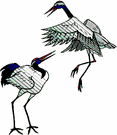Hello from Lamar,
Spent the day with my 5 year old granddaughter, CT and daughter-in-law MT on a great trip to the canyon areas of SECO. We were looking not only for birds and other wildlife but also to introduce the young one to the wonders of her backyard. The trip from Lamar south to Springfield produced 4 Red-tailed Hawks (RTHA), 2 Rough-legged Hawks (RLHA), 2 Western Meadowlarks (WEME), 4 American Kestrels (AMKE) several sparrow species which I suspect were American Tree Sparrows (ATSP) or White-crowned Sparrows (WCSP). Regardless, travelling HWY 287 at 70 MPH with all of the 16-wheelers and Holiday traffic, does not allow for anything but quick glimpses of birds.
The canyons are lovely, but extremely dry and the Picture Canyon area has been quite developed for visitors since my last visit when "Crack Cave" had yet to be an attraction and was still open for viewing during the equinox. I was able to make a trip with a ranger for the grasslands and archelogists studying the rock art of the canyons back in the late 80's. To see "Crack Cave" with bars on the entrance and all of the defacing of the wonderful "rock art" was a sad experience for me, today. On the brighter side, we saw many hundreds of Mountain Bluebirds (MOBL), Horned Larks (HOLA) raven sp, a Merlin (MERL), RTHA, RLHA, WEME, AMKE, sparrow species, Canyon Towhees (CATO), Green-tailed Towhees (GTTO) 2 Greater Roadrunners (GRRO) a favorite of CT and MT, Cedar Waxwings (CEWA), among others. On our visit to Carrizo Springs we did see one Song Sparrow (SOSP) and at all canyons we saw Dar-eyed Juncos (DEJU). At Cottonwood Canyon we saw many American Robins (AMRO) a couple of Northern Flickers (NOFL) and a Downy Woodpecker (DOWO) We saw 44 Wild Turkeys (WITU), 50 Mountain Sheep, I am not certain of the correct name here. We also saw Mule and White-tailed Deer and Antelope, rabbits, evidence of coyotes and rodents . There maybe a couple of others I am forgetting, but I felt it was more important for CT and MT to have the list to take home to Walsh.
We plan to explore the other canyons of SECO soon and will be doing a big trip on some private property in the canyons that is essentially unexplored by other birders or nature lovers. CT and MT can't wait and I am so glad to have the opportunity to introduce them to the wonders of SECO. We talked a lot about respecting property, especially when we saw litter and the defacing of the Native American rock art and it is easy to see why many of the gates of landowners that were open to visitors of the past are now closed.
Cheers,
JWT






















